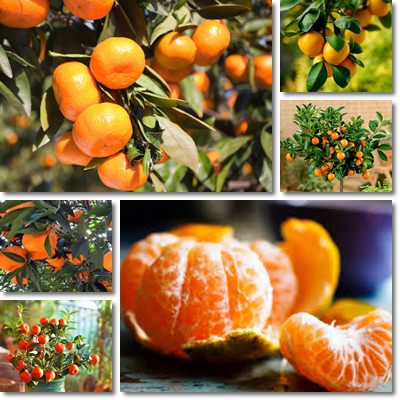The mandarin (Citrus reticulata) is a wonderful source of essential dietary nutrients that promote collagen synthesis, accelerate wound healing, optimize iron absorption, regulate bowel movement frequency, support immunity and protect cells against free radical damage, supporting digestive, cardiovascular and immune system health. Regular consumption of mandarins benefits eye health, boasts anti-aging effects and contributes to preventing degenerative chronic diseases.
What are mandarins?
The mandarin is also known as mandarine or mandarin orange and represents one of the four original citrus fruit, along with pomelo, citron and papeda. This means that citrus fruit such as oranges or grapefruit are natural hybrids occurring from the crossing of two original citrus fruit, in this case, pomelos and mandarins. Oranges, for instance, are 3/4 mandarins and 1/4 pomelo. The tangerine is a variety of mandarin, a cultivar of a deeper color than the bulk of commercial mandarins.
Also see the benefits of pomelo and the benefits of citron.

What do mandarins look like?
Mandarins are smaller than the average orange and have a looser, yet thick yellow-orange peel that comes off fairly easy. Their thick skin acts as a protection preventing harmful substances such as pesticides or insecticides from reaching the fruit. Just like oranges, mandarins are segmented, usually into 8-10 smaller pieces that can be easily separated from one another. Also, the albedo or pith, the white fibrous filaments in between the peel and the pulp, are edible as well as nutritious, which is why it is best to eat them along with the juicy pulp. The fruit may or may not contain seeds (some varieties are especially grown to bear no seeds). Tangerines are a variety of mandarins of a deeper red-orange color.
What do mandarins taste like?
Mandarins can be divided into two distinct groups as far as taste is concerned: sour mandarins and sweet mandarins.
- Sour mandarins have a highly acidic flavor which basically renders them inedible in raw form. These varieties are mostly used for making juice (with lots of added sugar) or as root stocks.
- Sweet mandarins can be eaten raw, made into juice or cooked in a variety of recipes ranging from fruit salads, tarts, crumbles, cake and pancakes to Chinese chicken salad, pork fry and various fish recipes.

What are the benefits of mandarin oranges?
As a result of their generous nutritional and antioxidant profile, mandarins are a precious addition to any diet. Find out below what are the most impressive 8 nutrition facts and health benefits of the mandarin orange:
Stimulates collagen synthesis and accelerates wound healing
Mandarins contain 26.7 mg of vitamin C per 100 g of juicy pulp. Vitamin C stimulates the production of collagen, a structural protein which ensures the integrity of about 1/4 of our body. It is found in skin, cartilage, ligaments, tendons, muscles, blood vessels, teeth and bones and ensures their structure. For instance, a high vitamin C intake ensures enough collagen is produced to help wounds heal faster and skin look firm and wrinkle-free longer.
Increases iron absorption
The good amounts of vitamin C in mandarins help optimize the absorption of iron in the intestines, leading to a better management of anemia and, consequently, less fatigue symptoms or fainting sensations and more energy to enjoy everyday life.
Provides antioxidant protection
Mandarins are rich in powerful antioxidants such as vitamin C, naringenin, hesperetin, vitamin A and carotenoids such as lutein and zeaxanthin. These natural flavonones, carotenoids and vitamins found in mandarins and other citrus fruit possess potent anti-inflammatory, antioxidant and free radical-scavenging properties, significantly reducing the risks of developing chronic diseases such as cancer, cardiovascular or neurodegenerative illnesses.
Possesses excellent antibacterial properties
Mandarins provide around 44% of the RDA of vitamin C and 23% of the RDA of vitamin A, two nutrients with excellent antibacterial properties. Vitamin C builds up immunity, while vitamin A protects sensitive mucous membranes at the level of the eyes, nose, mouth, throat, stomach and lungs from viruses and bacteria they may come in direct contact with.
Promotes eye health and good eyesight
The good amounts of vitamin A in mandarins contribute immensely to good eyesight. Vitamin A ensures good night vision (seeing in low light) as well as visual acuity. Lutein and zeaxanthin, also found in mandarin pulp, concentrate in the human retina and protect the eyes from free radical damage.
Wonderful tonic and energizer
Mandarins contain almost all essential dietary nutrients, ranging from B vitamins and vitamins A and C to calcium, copper, iron, potassium, magnesium, manganese and zinc. Eating them on a regular basis (preferably raw) will ensure a tonic action and energize and invigorate the body.
Mild natural laxative
Mandarins have about 1.8 g of indigestible plant material known as dietary fiber (hemicellulose, pectin) for each 100 g of pulp. Eating them can provide relief for both constipation and diarrhea primarily because of their pectin content, a form of dietary fiber which adds bulk to stools, promoting their excretion and, at the same time, increases stool viscosity, thickening stools that are too liquid.
Benefits the cardiovascular system
In addition to promoting regular bowel movements, the dietary fiber in mandarins prevents the fat from the foods we eat from being fully absorbed by the intestines and thus indirectly contributes to lowering LDL (bad) cholesterol levels.
Conclusion
Overall, mandarins (or tangerines) are a great addition to any diet. Not only are they sweet and juicy (and quite easy to peel), but they also provide a wide range of health benefits. Regular consumption can help regulate bowel movements, accelerate wound healing, maintain skin firmness, cardiovascular and eye health, but also energize the body, provide antioxidant protection and help better manage anemia by significantly increasing iron absorption.
